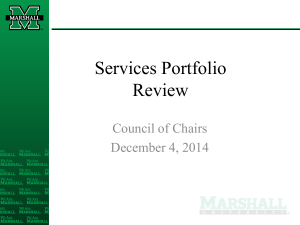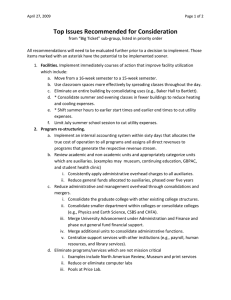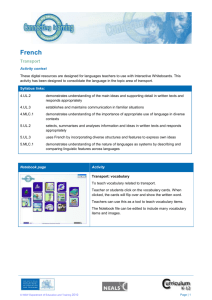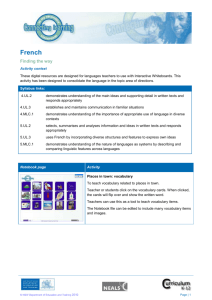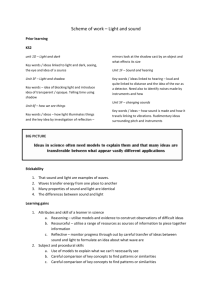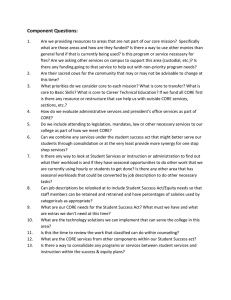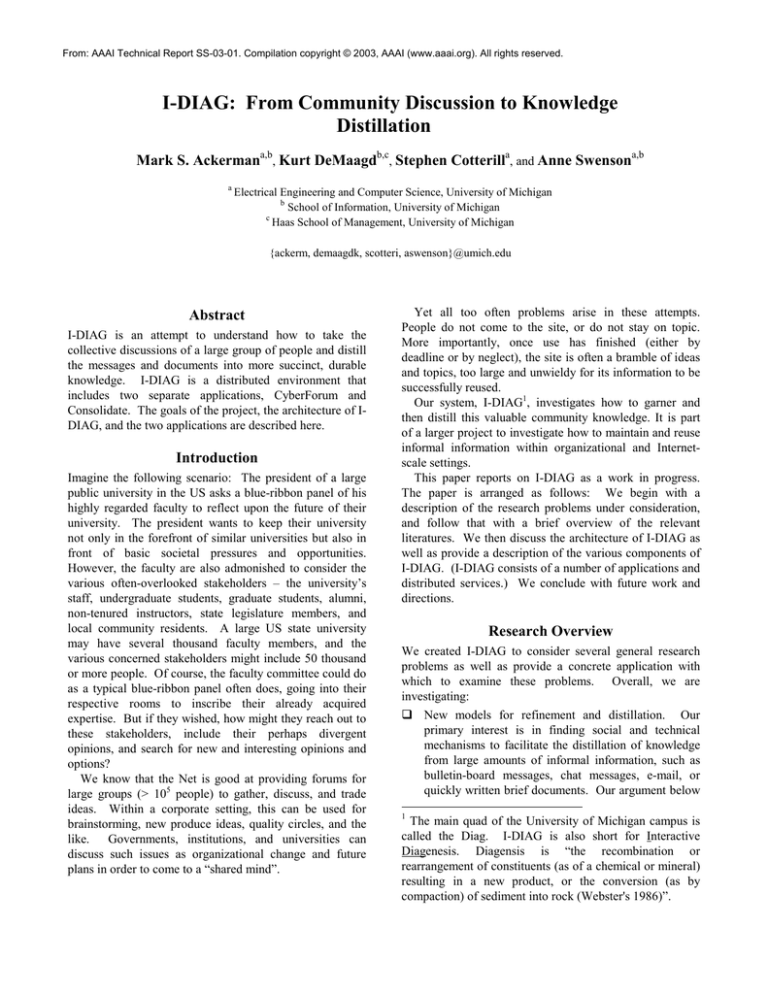
From: AAAI Technical Report SS-03-01. Compilation copyright © 2003, AAAI (www.aaai.org). All rights reserved.
I-DIAG: From Community Discussion to Knowledge
Distillation
Mark S. Ackermana,b, Kurt DeMaagdb,c, Stephen Cotterilla, and Anne Swensona,b
a
Electrical Engineering and Computer Science, University of Michigan
b
School of Information, University of Michigan
c
Haas School of Management, University of Michigan
{ackerm, demaagdk, scotteri, aswenson}@umich.edu
Abstract
I-DIAG is an attempt to understand how to take the
collective discussions of a large group of people and distill
the messages and documents into more succinct, durable
knowledge. I-DIAG is a distributed environment that
includes two separate applications, CyberForum and
Consolidate. The goals of the project, the architecture of IDIAG, and the two applications are described here.
Introduction
Imagine the following scenario: The president of a large
public university in the US asks a blue-ribbon panel of his
highly regarded faculty to reflect upon the future of their
university. The president wants to keep their university
not only in the forefront of similar universities but also in
front of basic societal pressures and opportunities.
However, the faculty are also admonished to consider the
various often-overlooked stakeholders – the university’s
staff, undergraduate students, graduate students, alumni,
non-tenured instructors, state legislature members, and
local community residents. A large US state university
may have several thousand faculty members, and the
various concerned stakeholders might include 50 thousand
or more people. Of course, the faculty committee could do
as a typical blue-ribbon panel often does, going into their
respective rooms to inscribe their already acquired
expertise. But if they wished, how might they reach out to
these stakeholders, include their perhaps divergent
opinions, and search for new and interesting opinions and
options?
We know that the Net is good at providing forums for
large groups (> 105 people) to gather, discuss, and trade
ideas. Within a corporate setting, this can be used for
brainstorming, new produce ideas, quality circles, and the
like. Governments, institutions, and universities can
discuss such issues as organizational change and future
plans in order to come to a “shared mind”.
Yet all too often problems arise in these attempts.
People do not come to the site, or do not stay on topic.
More importantly, once use has finished (either by
deadline or by neglect), the site is often a bramble of ideas
and topics, too large and unwieldy for its information to be
successfully reused.
Our system, I-DIAG1, investigates how to garner and
then distill this valuable community knowledge. It is part
of a larger project to investigate how to maintain and reuse
informal information within organizational and Internetscale settings.
This paper reports on I-DIAG as a work in progress.
The paper is arranged as follows: We begin with a
description of the research problems under consideration,
and follow that with a brief overview of the relevant
literatures. We then discuss the architecture of I-DIAG as
well as provide a description of the various components of
I-DIAG. (I-DIAG consists of a number of applications and
distributed services.) We conclude with future work and
directions.
Research Overview
We created I-DIAG to consider several general research
problems as well as provide a concrete application with
which to examine these problems. Overall, we are
investigating:
New models for refinement and distillation. Our
primary interest is in finding social and technical
mechanisms to facilitate the distillation of knowledge
from large amounts of informal information, such as
bulletin-board messages, chat messages, e-mail, or
quickly written brief documents. Our argument below
1
The main quad of the University of Michigan campus is
called the Diag. I-DIAG is also short for Interactive
Diagenesis. Diagensis is “the recombination or
rearrangement of constituents (as of a chemical or mineral)
resulting in a new product, or the conversion (as by
compaction) of sediment into rock (Webster's 1986)”.
is that previous mechanisms have failed because of the
social barriers. Accordingly, our emphasis is less on
the technical mechanisms for doing textual
summarization or knowledge elicitation than on
finding social models with augmentative technical
mechanisms to foster the creation of material and then
“boiling down” of that material into something that
will be subsequently useful to others.
These “boiled down” repositories are the distilled and
refined versions of many people’s thoughts about a
subject, mostly likely specific to a particular sociotechnical environment. We are also investigating
mechanisms to foster the sustainability of this distilled
repository over time.
In any social space, mechanisms must exist to foster
social regulation and sustainability over time (as in
Ackerman and Palen 1996). While social regulation
can have pejorative connotations for computer people,
some amount is necessary to continue any
collectivity’s activities. It seems as though there are
always problem or abusive users in online spaces. We
also wish to prevent or ameliorate unproductive or
hateful exchanges. As we will see, the duration for IDIAG is very short. Nonetheless, there are still social
regulation and maintenance issues to be resolved;
indeed, some may be exacerbated by use assumed to
be brief. Through I-DIAG we are investigating user
and collaborative interface mechanisms to quickly
move users into an understanding of the system and its
uses, enable productive exchanges, and control
potentially unruly users and problematic exchanges.
Since we hope that use is rapid and the corpus of
information is constructed very quickly, we are
investigating interface mechanisms to allow users to
return to the space and understand what is new quickly
and effectively.
We hope to produce interface
guidelines for these types of spaces.
Overall, we see ourselves as investigating new forms
of knowledge management.
I-DIAG forms an
interactive or dynamic “book”, where the corpus is
constructed iteratively and collaboratively by people
with different opinions, types of expertise, and
varieties of experience and viewpoints. This “book” is
a living document – not only is it constructed by
people in terms of their own interests and knowledge,
but it can be maintained over time in the same manner.
Our major goal, then, is to understand how to iteratively
construct a refined knowledge repository (probably less
than completely formalized but more distilled than raw
messages). To do so, we must necessarily also investigate
what technical and social mechanisms we need for
sustainability, social regulation and maintenance,
navigation and return, and interface metaphors.
In order to examine these broad issues, we have created
a particular problem scenario and the computational
system to solve it. The scenario in the introduction
describes most of the problem we are addressing. It is a
“brainstorming system”, a system in which people can
come together to offer ideas and debate them. Figures 2-4
show the specific testbed we have created to investigate
these issues. A few points should be noted about the
application and the environment:
In keeping with the Internet philosophy of utilizing
thousands of eyeballs, I-DIAG attempts to harness
small amounts of time from thousands of users.
Motivations for using the system come from everyday
activity. We hope to have some small number of core
users, who will be key contributors, but we expect
small contributions from a much larger number of
people. At the end, we expect only a handful of
people to distill the material.
In our standard scenario of use, we are assuming the
site will be used actively for a brief period of time –
two weeks in our current plans. This allows people to
have a healthy and vigorous discussion on specific
topics, and then the site can close down before the
topic becomes obsolete or stale. It also provides us a
time to start mining the discussion as a final product –
namely the final report and/or a distilled, concise web
site of responses and ideas.
I-DIAG, accordingly, has three sets of users. The first
user group consists of the people entering their
comments and discussing appropriate topics. The
second user group consists of the moderators, editors,
and wizards that control the interactive discussion.
The final set consists of the people distilling the
archived materials, either for an external report or to
create a more concise site.
The precise outcome of any given I-DIAG installation
may not be known in advance. Some instantiations
may wish a linear book as their outcome. The
distillation process for that would likely be different
when one wishes a concise site as the outcome. In
addition, the scope of the distillation might vary –
some sites may wish to include every point of view
and every significant issue; other sites may wish to
merely keep subdiscussions or interesting points.
I-DIAG, then, is an attempt to reconsider knowledge
management and knowledge communities. It attempts to
create incentives for use and reuse by differing groups of
people, all of whom iteratively construct the space and the
knowledge through their activities.
Relevant Literatures and Related Systems
Several diverse literatures bring appropriate insights and
prior work.
Of direct relevance here are a number of approaches to
distillation and summarization. In an older Education
literature, one can find descriptions of “advanced
organizers,” organization tools for structuring educational
lessons or materials (Jonassen, Beissner, and Yacci 1993).
Although over time, the term came to be known as a
technique for textual or oral materials (similar to
foreshadowing), originally these included visual
organizers. These visual organizers included timelines,
web of relationships, trees of concepts, and the like. Many
of the visual interfaces are directly relevant to our efforts
to provide organization tools to users; however, these
visual interfaces, we feel, are only part of what is needed.
Similar in intent to the literature on visual organizers is
an important paper on incremental formalization in
hypertext (Shipman and Marshall 1999, Shipman and
McCall 1999, Shipman and McCall 1994). Visual
organizers allow one to slowly increase the amount of
organization in one’s material by presenting more
conceptually-oriented views on that material. This idea
has been generalized in Shipman’s work. These papers
argue is that one should consider how to allow incremental
formalization over time: Users may wish to enter free text
initially and slowly increase the level of organization and
formalisms in their material. Incremental formalization is
critical to how I-DIAG works.
As well, I-DIAG uses techniques derived from and
similar to text summarization. Text summarization (e.g.,
Radev and Hovy 1999) attempts to consolidate large
documents or sets of documents into abstracts or shorter
documents. Many of the techniques are relevant to IDIAG, but again these techniques are only part of what is
needed.
I-DIAG is related to a number of different Computer
Supported Cooperative Work (CSCW) systems (also called
collaborative systems here). I-DIAG is obviously an ecommunity system. Largely studied for their social effects
(e.g., Sproull and Kiesler 1991, Wenger 1998), these
systems do not have a large technical research literature.
(A general overview of deployed technology, however, can
be found in Preece 2000.)
I-DIAG also has similarities to a variety of
brainstorming systems that have been investigated over the
years. Generally, most such systems have been deployed
and studied within face-to-face and distributed work
meetings (e.g., Nunamaker et al. 1991, Streitz et al. 1994).
A number of studies have shown that the use
brainstorming systems provides more ideas and more
creative insight to a problem (Dennis et al. 1999).
However, since the use of these systems has been limited
to single-session meetings, little has been studied about the
social structures of use over time, or the technology and
human-computer interface mechanisms required to support
that use over time.
One large-scale brainstorming system reported in the
research literature was the White House ‘s Open Meeting
on the National Performance Review (Hurwitz and
Mallery 1995). Using the system, users “discussed,
evaluated, and critiqued recommendations by linking their
comments to points in the evolving policy hypertext.”
As well, the evolving discussions in I-DIAG could serve
as a rudimentary design or decision rationale system
(Conklin and Begeman 1988, MacLean et al. 1990, Moran
and Carroll 1996). In a decision rationale, users follow an
ontology with an implicit social process in order to create a
coherent, well-structured argument that can be viewed by
others at a later time. The goal is to help future readers
understand that decision and perhaps reuse portions of the
rationale in their own decision processes. However, as
Grudin points out in Moran and Carroll (1996), users must
do considerable upfront work for an unclear future payoff,
and thus, users will be reluctant to actually go to the extra
work to construct the rationale argument.
I-DIAG
attempts to provide suitable incentives for all of the users
of the system by separating the argumentation from the
distillation.
Finally, in our own earlier work, we examined
collaborative systems for the distillation process
(Ackerman and McDonald 1996).
The Collaborative
Refinery (Co-Refinery) system supported a four-step
process (although the steps could be done in any order).
Collecting was the act of obtaining material for a
collection, and culling was removing superfluous or
redundant material from the collection. More importantly,
Co-Refinery supported organizing and distilling the
materials. I-DIAG takes its beginning point from CoRefinery and its mechanisms.
In summary, considerable work has been done on
creating, fostering, and governing e-communities.
Systems have also been created to foster and support
brainstorming and decision rationale on-line. However,
there has been little work, to date, on distilling informal
information, especially group brainstorming results.
http
DIAG
Consolidate
DIAG
CyberForum
db
visualizers
social maintenance
agents
information maintenance agents
meta-data taggers
information gatherers
expertise finders
Figure 1: I-DIAG architecture
Architecture and Services
Differing users and their tasks suggested multiple
applications, rather than trying to do everything in one
Web-based application. For the discussion portion of IDIAG, the interface requirements are relatively low. A
Web-based interface could handle those requirements, and
so we could consider customizing one of many Web-based
discussion systems.
On the other hand, there are
substantial interface requirements for interactively
handling sense-making, collaborative, and ad-hoc
representations of complex intellectual spaces. Web-based
interfaces would likely be marginal.
Therefore, we constructed I-DIAG instead as an
environment into which new applications and auxiliary
agents can easily be added. The architecture allows a
gradation between user-controlled applications and
autonomous agents. The architecture is shown in Figure 1.
As many Web-based applications have, I-DIAG has a
database at its core. For I-DIAG, the database stores
largely hypermedia objects as well as meta-data.
Applications (discussed immediately below) and agents
feed to and from the database. As new services are
developed, they can be placed into the architecture easily.
We expect some of these services and applications to
consist of relatively standard software projects; others will
consist of research prototypes.
CyberForum
The front-end, discussion service is called IDIAG/CyberForum (CyberForum).
CyberForum is a
typical Web discussion site. It is an application built upon
the open-source Everything2 engine (essentially the same
as that used by the Slashdot site). Everything2 provides
CyberForum with the capability for message creation,
editing, and storing. Support is provided for constructing
displays, linking, and threading.
This application is absolutely essential to solving the
scenario problem described in the introduction. While the
effort of constructing the CyberForum application was
relatively straightforward engineering, it did require
substantial effort. The raw engine provides only the basic
underlying services; without additional programming, little
could be done. Figure 2 shows the CyberForum home
page.
In addition to the basic application engineering, several
research problems had to be addressed. As mentioned
above, at a social level, we have had to consider additional
collaborative mechanisms to facilitate social interaction
and regulation. Because CyberForum is intended for
relatively short-term use – a few weeks or a month for a
particular site – the system has had to be optimized not
only for performance efficiency (as does any Web
application) but also for social maintenance. Social
maintenance includes how to motivate users to come to
and continue to participate at the site (social facilitation) as
well as how to deal with problem users (social regulation).
To support these requirements, we have added:
Facilities to allow people to easy come in and out of
discussions. In order for users to return to the site
over time, it is important for them to be able to easily
determine the current state of discussions as well as
see what is new. We are providing a series of
visualizations to help users orient themselves.
User facilities to see what messages someone has
posted. This not only provides a motivation for users
to post, it also allows some pre-processing for later
distillation. Moderators can highlight interesting posts
for other users. Moreover, they can annotate, discuss,
or merely note interesting posts for later examination.
Summaries to close problematic discussions. For
example, one may wish to summarize the perennial
and inconclusive argument about whether people
should use Macs or PCs, closing off I-DIAG to this
off-topic discussion. More importantly, it may be
important to summarize and close off discussion of
socially divisive arguments (e.g., affirmative action,
the place of minorities in the institution under
discussion). These summaries can provide a visual
consolidation with further discussion allowed, a
closing-off of further discussion, or a conclusion to an
extended discussion. Figure 3 shows one summary, as
well as a message thread.
We expect to add additional services to support the
social requirements as we use CyberForum in limited field
tests. Recently, we have begun to make our rating
mechanism more flexible, especially with regard to the
visual indicators for a message’s rating by other users.
At a technical level, we had to add three major
additional facilities to the Everything2 engine in order to
create our computational architecture. In order to have
external agents, we added a SOAP interface. Everything2
out of the box does not support communication with
external programs. This facility gives us many additional
capabilities. For example, we could more easily change the
base rating system by using an external agent to monitor
discrepancies.
To facilitate the social processes around editing and
moderating of messages, we added a base layer of process
support as well as a facility that allows the system to be
easily reconfigured into a number of social formations.
For example, we can easily switch from a free-flowing
discussion to a moderated discussion (with a single
moderator/editor) to a discussion moderated by an editorial
board (where there must be a majority vote in favor).
These latter facilities are critical to our efforts at social
regulation and maintenance.
Consolidate
The second major application in the I-DIAG environment
is I-DIAG/Consolidate (Consolidate). Consolidate, in our
scenario of use, will be used by experts to consolidate and
distill the messages and organization of the site once
people have finished with CyberForum. Consolidate
consists of an extremely flexible core system that ties
together extensible views, a query service, and
visualizations of the information (in this case, messages,
threads, topics, and people) and its structure
Consolidate provides for collaborative use through
shared views. The data for these shared views can be
handled through a variety of replication engines; currently
Figure 2: CyberForum home page
a simple replication scheme is supported. Through the
shared views, multiple editors can discuss and consolidate
differing organizations of the raw information. Multiple
messages, as well as additional information (e.g., editor
notes, links to external references), can be consolidated
into summary nodes. Figure 4 shows an outline view of a
topic; the icon in the lower right corner (which is normally
in red) signals that this is a view shared with others.
In Consolidate, editors can place messages into multiple
topics or even rearrange the topics themselves. While
Everything2 and hence CyberForum-requires that all
messages have only one parent, Consolidate does not.
This is particularly important for knowledge distillation.
Nodes can clearly be about multiple topics. In addition,
editors may wish to keep their own lists of interesting
nodes, nodes by certain people, and other kinds of working
lists.
In addition to views of the information, Consolidate
contains a query service used to find new relationships.
The query service currently allows users to retrieve based
on topic, date, keywords, and author. We believe that a
major use will be retrieval by author. Many times one
finds an unusually perspicacious or even offbeat author,
and wishes to find other postings by the same author. In
the future, we plan a “reduced keyword” query based on
latent semantic indexing. In this query, both the message
space and the query are mapped to an approximately 100
dimensional space; this can improve retrieval, especially
for short messages.
Consolidate also contains a number of semi-autonomous
agents. Some will be used to crunch visualizations of the
messages. Editors must search for outliers, either to
eliminate them from a consolidated site or to make them
prominent because they have novel or offbeat ideas.
Implementation
Currently, both applications have been built. CyberForum
consists of over 40,000 lines of Perl code, over and above
the base Everything2 engine and our extensions. Our
prototypes external agents are written in Java and are
currently rather minor; the largest is several hundred lines
of Java code. I-DIAG/Consolidate is constructed in Java
and Jython, the Java implementation of the Python
language. (Consolidate uses Jython as both an internal
scripting language as well as a scripting language for usercreated agents and user-modified views.) Consolidate
currently consists of approximately 16,000 lines of Java
code. Consolidate runs on any Java platform; CyberForum
requires Debian Linux, a MySQL database, and an Apache
Web server.
Only CyberForum is ready for full deployment. We are
currently testing CyberForum in a limited field study
Figure 3: CyberForum summary and messages
Figure 4: A Consolidate viewsheet
consisting of two University of Michigan classes. We are
planning a larger scale field test in the near future using
both CyberForum and Consolidate.
Conklin, Jeff, and Michael L. Begeman. 1988. gIBIS: A
Hypertext Tool for Exploratory Policy Discussion.
Proceedings of the CSCW '88 : 140-152.
Acknowledgements
Dennis, Alan R., Jay E. Aronson, William G. Heninger,
and Edward D. Walker. 1999. Structuring time and task in
electronic brainstorming. 23 (1) : 95-108.
This work has been funded, in part, by the National
Science Foundation (IRI-9702904) and the University of
Michigan/School of Information Alliance for Community
Technology.
Portions of I-DIAG Consolidate were
originally funded by the MIT/Laboratory for Computer
Science Project Oxygen Partnership. We would like to
thank Dan Atkins, Cliff Lampe, and George Furnas for
their insights on these issues.
References
Ackerman, Mark S., and David W. McDonald. 1996.
Answer Garden 2: Merging Organizational Memory with
Collective Help. Proceedings of the ACM Conference on
Computer-Supported Cooperative Work (CSCW'96) : 97105.
Ackerman, Mark S., and Leysia Palen. 1996. The Zephyr
Help Instance: Promoting Ongoing Activity in a CSCW
System. Proceedings of the ACM Conference on Human
Factors in Computing Systems (CHI'96) : 268-275.
Hurwitz, Roger, and John C. Mallery. 1995. The Open
Meeting: A Web-Based System for Conferencing and
Collaboration. Proceedings of the The Fourth
International Conference on The World-Wide Web
Jonassen, David H., Katherine Beissner, and Michael
yacci. 1993. Structural Knowledge:
Techniques for
Representing, Conveying, and Acquiring Structural
Knowledge. Hillsdale, NJ: Lawrence Erlbaum Associates.
MacLean, Allan, Richard Young, Victoria Bellotti, and
Thomas Moran. 1990. Questions, Options, and Criteria:
Elements of a Design Rationale for User Interfaces.
EuroPARC/AMODEUS.
Moran, Thomas P., and John M. Carroll. 1996. Design
Rationale: Concepts, Techniques, and Use. Lawrence
Erlbaum.
Nunamaker, J. F., Alan R. Dennis, Joseph S. Valacich,
Douglas Vogel, and Joey F. George. 1991. Electronic
meeting systems. 34 (7) : 40-61.
Preece, Jenny. 2000. Online Communities.
Wiley.
New York:
Radev, Dragomir R., and Eduard Hovy. 1999. Intelligent
text summarization. 3
Shipman, Frank, and Cathy Marshall. 1999. Formality
Considered Harmful: Experiences, Emerging Themes, and
Directions on the Use of Formal Representations in
Interactive Systems. 8 (4) : 333-352.
Shipman, Frank, and Ray McCall. 1999. Supporting
Incremental Formalization with the Hyper-Object
Substrate. 17 (2) : 199-227.
Shipman, Frank M., III, and Raymond McCall. 1994.
Supporting Knowledge-Base Evolution with Incremental
Formalization. Proceedings of the ACM Conference on
Human Factors in Computing Systems (CHI'94) : 285-291.
Sproull, Lee, and Sara Kiesler. 1991. Connections: New
Ways of Working in the Networked Organization.
Cambridge, MA: MIT Press.
Streitz, Norbert A., Jörg Geißler, Jörg M. Haake, and
Jeroen Hol. 1994. DOLPHIN: integrated meeting support
across local and remote desktop environments and
LiveBoards. Proceedings of the ACM conference on
Computer supported cooperative work (CSCW'94) : 345358.
Webster's. 1986. Webster's Ninth New Collegiate
Dictionary. Springfield, MA: Merriam-Webster.
Wenger, Etienne. 1998. Communities of practice :
learning, meaning, and identity. New York: Cambridge
University Press.

